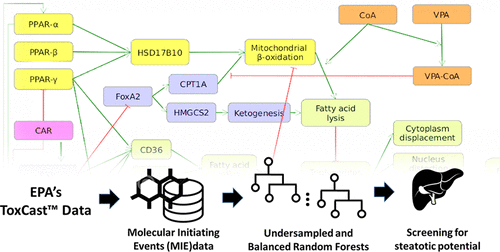当前位置:
X-MOL 学术
›
J. Chem. Inf. Model.
›
论文详情
Our official English website, www.x-mol.net, welcomes your
feedback! (Note: you will need to create a separate account there.)
QSAR Modeling of ToxCast Assays Relevant to the Molecular Initiating Events of AOPs Leading to Hepatic Steatosis
Journal of Chemical Information and Modeling ( IF 5.6 ) Pub Date : 2018-06-27 00:00:00 , DOI: 10.1021/acs.jcim.8b00297 Domenico Gadaleta 1 , Serena Manganelli 1 , Alessandra Roncaglioni 1 , Cosimo Toma 1 , Emilio Benfenati 1 , Enrico Mombelli 2
Journal of Chemical Information and Modeling ( IF 5.6 ) Pub Date : 2018-06-27 00:00:00 , DOI: 10.1021/acs.jcim.8b00297 Domenico Gadaleta 1 , Serena Manganelli 1 , Alessandra Roncaglioni 1 , Cosimo Toma 1 , Emilio Benfenati 1 , Enrico Mombelli 2
Affiliation

|
Nonalcoholic hepatic steatosis is a worldwide epidemiological concern since it is among the most prominent hepatic diseases. Indeed, research in toxicology and epidemiology has gathered evidence that exposure to endocrine disruptors can perturb cellular homeostasis and cause this disease. Therefore, assessing the likelihood of a chemical to trigger hepatic steatosis is a matter of the utmost importance. However, systematic in vivo testing of all the chemicals humans are exposed to is not feasible for ethical and economical reasons. In this context, predicting the molecular initiating events (MIE) leading to hepatic steatosis by QSAR modeling is an issue of practical relevance in modern toxicology. In this article, we present QSAR models based on random forest classifiers and DRAGON molecular descriptors for the prediction of in vitro assays that are relevant to MIEs leading to hepatic steatosis. These assays were provided by the ToxCast program and proved to be predictive for the detection of chemical-induced steatosis. During the modeling process, special attention was paid to chemical and toxicological data curation. We adopted two modeling strategies (undersampling and balanced random forests) to develop robust QSAR models from unbalanced data sets. The two modeling approaches gave similar results in terms of predictivity, and most of the models satisfy a minimum percentage of correctly predicted chemicals equal to 75%. Finally, and most importantly, the developed models proved to be useful as an effective in silico screening test for hepatic steatosis.
中文翻译:

与导致肝脂肪变性的AOP分子启动事件相关的ToxCast分析的QSAR建模
非酒精性肝脂肪变性是全世界最流行的肝病之一,因此引起全世界的流行病学关注。实际上,毒理学和流行病学方面的研究已经收集到证据,表明暴露于内分泌干扰物会扰乱细胞体内稳态并导致这种疾病。因此,评估化学物质触发肝脂肪变性的可能性至关重要。但是,系统的体内由于道德和经济原因,对人类所接触的所有化学物质进行测试是不可行的。在这种情况下,通过QSAR建模预测导致肝脂肪变性的分子启动事件(MIE)是现代毒理学中实际相关的问题。在本文中,我们介绍了基于随机森林分类器和DRAGON分子描述符的QSAR模型,用于体外预测与导致肝脂肪变性的MIE相关的检测方法。这些测定由ToxCast程序提供,并被证明可预测化学诱导的脂肪变性。在建模过程中,要特别注意化学和毒理学数据的管理。我们采用两种建模策略(欠采样和平衡随机森林)从不平衡数据集中开发出健壮的QSAR模型。两种建模方法在可预测性方面给出了相似的结果,并且大多数模型都满足正确预测的化学物质的最小百分比等于75%的要求。最后,也是最重要的是,开发的模型被证明可作为有效的肝脂肪变性计算机筛查试验。
更新日期:2018-06-27
中文翻译:

与导致肝脂肪变性的AOP分子启动事件相关的ToxCast分析的QSAR建模
非酒精性肝脂肪变性是全世界最流行的肝病之一,因此引起全世界的流行病学关注。实际上,毒理学和流行病学方面的研究已经收集到证据,表明暴露于内分泌干扰物会扰乱细胞体内稳态并导致这种疾病。因此,评估化学物质触发肝脂肪变性的可能性至关重要。但是,系统的体内由于道德和经济原因,对人类所接触的所有化学物质进行测试是不可行的。在这种情况下,通过QSAR建模预测导致肝脂肪变性的分子启动事件(MIE)是现代毒理学中实际相关的问题。在本文中,我们介绍了基于随机森林分类器和DRAGON分子描述符的QSAR模型,用于体外预测与导致肝脂肪变性的MIE相关的检测方法。这些测定由ToxCast程序提供,并被证明可预测化学诱导的脂肪变性。在建模过程中,要特别注意化学和毒理学数据的管理。我们采用两种建模策略(欠采样和平衡随机森林)从不平衡数据集中开发出健壮的QSAR模型。两种建模方法在可预测性方面给出了相似的结果,并且大多数模型都满足正确预测的化学物质的最小百分比等于75%的要求。最后,也是最重要的是,开发的模型被证明可作为有效的肝脂肪变性计算机筛查试验。











































 京公网安备 11010802027423号
京公网安备 11010802027423号